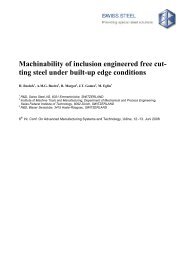Application of Thermodynamic Model for Inclusion Control in ...
Application of Thermodynamic Model for Inclusion Control in ...
Application of Thermodynamic Model for Inclusion Control in ...
Create successful ePaper yourself
Turn your PDF publications into a flip-book with our unique Google optimized e-Paper software.
Figure 7. Step 1: Design <strong>of</strong> LMF slag: Prediction <strong>of</strong> optimum slag<br />
composition (based on slag-melt equilibration) to control the demanded<br />
soluble Al and O <strong>of</strong> the melt <strong>in</strong> LMF.<br />
Figure 7. Step 2: Design <strong>of</strong> deoxidation <strong>in</strong> LMF: Prediction <strong>of</strong> exogenous<br />
<strong>in</strong>clusions after Ca treatment (based on slag-metal equilibrium).<br />
Figure 7. Step 3:. Design <strong>of</strong> deoxidation <strong>in</strong> the cont<strong>in</strong>uous caster:<br />
Prediction <strong>of</strong> <strong>in</strong>digenous <strong>in</strong>clusions (based on the melt chemistry<br />
and thermodynamic equilibrium) after solidification <strong>in</strong> the caster.<br />
Process Metallurgy – Steelmak<strong>in</strong>g<br />
<strong>in</strong>clusion were analysed. Because <strong>of</strong> their high amount, sulphides<br />
have been filtered out by adequate trigger levels <strong>of</strong><br />
the reflected signals. Neglect<strong>in</strong>g all measurements with<br />
Fe>40% (too much matrix) and with S>10% (dom<strong>in</strong>ant sulphide<br />
content) 174 particles were detected. From them 158<br />
could be identified either as CaO-Al2O3-SiO2-type (exogenous)<br />
or MnO-Al2O3-SiO2-type (<strong>in</strong>digenous). Figure 8 and<br />
9 show the compositions <strong>of</strong> the measured <strong>in</strong>clusions <strong>in</strong> the<br />
correspond<strong>in</strong>g ternary diagrams. Their chemical compositions<br />
are <strong>in</strong> good agreement with the thermodynamic prediction<br />
(assum<strong>in</strong>g thermodynamic equilibrium). The <strong>in</strong>clusions<br />
are located <strong>in</strong> the dark areas <strong>of</strong> the target glassy <strong>in</strong>clusion<br />
regions.<br />
Mach<strong>in</strong>ability tests. The mach<strong>in</strong>ability tests (s<strong>in</strong>gle<br />
po<strong>in</strong>t turn<strong>in</strong>g ) were per<strong>for</strong>med <strong>in</strong> case <strong>of</strong> the flank wear<br />
Figure 8. EDX analysis <strong>of</strong> exogenous oxide <strong>in</strong>clusions <strong>of</strong> CaO-<br />
Al2O3-SiO2 <strong>in</strong> <strong>in</strong>clusion eng<strong>in</strong>eered 11SMn37steel (as rolled).<br />
Figure 9. EDX analysis <strong>of</strong> <strong>in</strong>digenous oxide <strong>in</strong>clusions <strong>of</strong> MnO-<br />
Al2O3-SiO2 <strong>in</strong> <strong>in</strong>clusion eng<strong>in</strong>eered 11SMn37steel (as rolled).<br />
steel research <strong>in</strong>t. 75 (2004) No. 5 319










